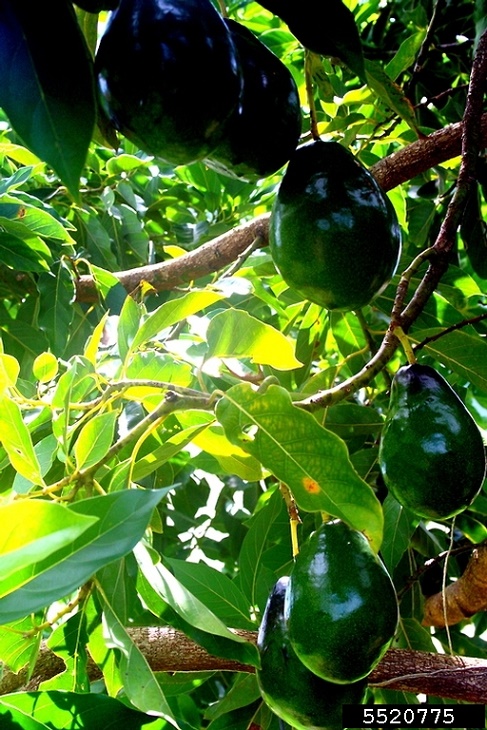Difference between revisions of "Persea americana"
HaleighJoM (talk | contribs) (→Ecology) |
|||
| (6 intermediate revisions by 3 users not shown) | |||
| Line 3: | Line 3: | ||
{{taxobox | {{taxobox | ||
| name = Persea americana | | name = Persea americana | ||
| − | | image = | + | | image = Pers_amer.jpg |
| − | | image_caption = | + | | image_caption = Photo by Jake Farnum, [http://www.forestryimages.org Bugwood.org] |
| regnum = Plantae | | regnum = Plantae | ||
| divisio = Magnoliophyta - Flowering plants | | divisio = Magnoliophyta - Flowering plants | ||
| Line 18: | Line 18: | ||
}} | }} | ||
| − | Common name: | + | Common name: Avocado |
| − | ==Description== | + | ==Taxonomic notes== |
| − | <!-- Basic life history facts such as annual/perrenial, monoecious/dioecious, root morphology, seed type, etc. --> | + | ==Description== <!-- Basic life history facts such as annual/perrenial, monoecious/dioecious, root morphology, seed type, etc. --> |
| − | |||
==Distribution== | ==Distribution== | ||
==Ecology== | ==Ecology== | ||
| − | ===Habitat=== <!--Natural communities, human disturbed habitats, topography, hydrology, soils, light, fire regime requirements for removal of competition, etc.--> | + | <!--===Habitat===--> <!--Natural communities, human disturbed habitats, topography, hydrology, soils, light, fire regime requirements for removal of competition, etc.--> |
| − | ===Phenology=== <!--Timing off flowering, fruiting, seed dispersal, and environmental triggers. Cite PanFlora website if appropriate: http://www.gilnelson.com/PanFlora/ --> | + | <!--===Phenology===--> <!--Timing off flowering, fruiting, seed dispersal, and environmental triggers. Cite PanFlora website if appropriate: http://www.gilnelson.com/PanFlora/ --> |
| − | ===Seed dispersal=== | + | <!--===Seed dispersal===--> |
| − | ===Seed bank and germination=== | + | <!--===Seed bank and germination===--> |
| − | ===Fire ecology=== <!--Fire tolerance, fire dependence, adaptive fire responses--> | + | <!--===Fire ecology===--> <!--Fire tolerance, fire dependence, adaptive fire responses--> |
===Pollination=== | ===Pollination=== | ||
| − | The following Hymenoptera families and species were observed visiting flowers of ''Persea americana'' at Archbold Biological Station | + | The following Hymenoptera families and species were observed visiting flowers of ''Persea americana'' at Archbold Biological Station:<ref name="Deyrup 2015">Deyrup, M.A. and N.D. 2015. Database of observations of Hymenoptera visitations to flowers of plants on Archbold Biological Station, Florida, USA.</ref> |
Vespidae: ''Stenodynerus beameri'' | Vespidae: ''Stenodynerus beameri'' | ||
| + | <!--===Herbivory and toxicology===--> <!--Common herbivores, granivory, insect hosting, poisonous chemicals, allelopathy, etc--> | ||
| + | <!--===Diseases and parasites===--> | ||
| + | |||
| + | ==Conservation, cultivation, and restoration== | ||
| − | == | + | ==Cultural use== |
| − | |||
| − | |||
| − | |||
==Photo Gallery== | ==Photo Gallery== | ||
==References and notes== | ==References and notes== | ||
| − | |||
Latest revision as of 08:23, 15 July 2022
| Persea americana | |
|---|---|

| |
| Photo by Jake Farnum, Bugwood.org | |
| Scientific classification | |
| Kingdom: | Plantae |
| Division: | Magnoliophyta - Flowering plants |
| Class: | Magnoliopsida – Dicotyledons |
| Order: | Laurales |
| Family: | Lauraceae |
| Genus: | Persea |
| Species: | P. americana |
| Binomial name | |
| Persea americana Mill. | |

| |
| Natural range of Persea americana from USDA NRCS Plants Database. | |
Common name: Avocado
Contents
Taxonomic notes
Description
Distribution
Ecology
Pollination
The following Hymenoptera families and species were observed visiting flowers of Persea americana at Archbold Biological Station:[1]
Vespidae: Stenodynerus beameri
Conservation, cultivation, and restoration
Cultural use
Photo Gallery
References and notes
- ↑ Deyrup, M.A. and N.D. 2015. Database of observations of Hymenoptera visitations to flowers of plants on Archbold Biological Station, Florida, USA.